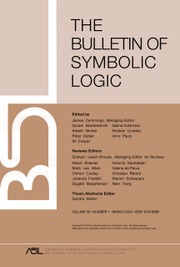Article contents
Local Definitions in Degree Structures: The Turing Jump, Hyperdegrees and Beyond
Published online by Cambridge University Press: 15 January 2014
Abstract
There are Π5 formulas in the language of the Turing degrees, D, with ≤, ⋁ and ⋀, that define the relations x″ ≤ y″, x″ = y″ and so x ∈ L 2(y) = {x ≥ y ∣ x″ = y″} in any jump ideal containing 0 (ω). There are also Σ6 & Π6 and Π8 formulas that define the relations w = x″ and w = x′, respectively, in any such ideal I. In the language with just ≤ the quantifier complexity of each of these definitions increases by one. On the other hand, no Π2 or Σ2 formula in the language with just ≤ defines L 2 or x ∈ L 2(y). Our arguments and constructions are purely degree theoretic without any appeals to absoluteness considerations, set theoretic methods or coding of models of arithmetic. As a corollary, we see that every automorphism of I is fixed on every degree above 0″ and every relation on I that is invariant under double jump or joining with 0″ is definable over I if and only if it is definable in second order arithmetic with set quantification ranging over sets whose degrees are in I. Similar direct coding arguments show that every hyperjump ideal I is rigid and biinterpretable with second order arithmetic with set quantification ranging over sets with hyperdegrees in I. Analogous results hold for various coarser degree structures.
Information
- Type
- Communications
- Information
- Copyright
- Copyright © Association for Symbolic Logic 2007
References
REFERENCES
- 1
- Cited by

